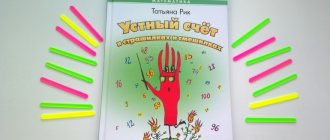Health-saving technologies
Health-saving technologies are aimed at strengthening the child’s health and instilling in him a healthy lifestyle. This is especially relevant in light of environmental deterioration, general health, and poor nutrition.
Health-saving technologies can be implemented in different ways. Depending on the goals:
- they can be aimed at maintaining health and implemented by medical personnel: nutrition control, health monitoring, providing a health-preserving environment;
- they can be aimed at the physical development of the child through various types of gymnastics (breathing, finger, orthopedic), hardening, dynamic pauses, stretching, alternative methods - for example, hatha yoga;
- they can introduce a culture of health;
- they can teach a healthy lifestyle through communicative games, game sessions, logarithmics, physical education classes;
- they can be corrective and implemented in sessions of various types of therapies (art, fairy tale, color).
Stages of using gaming technologies in the educational process in preschool educational institutions
Gaming technologies are being introduced into the educational process of preschool educational institutions in stages. The activities of preschoolers are built on the basis of the creative use of games and play activities in the educational process of preschool educational institutions and meeting the needs and interests of preschoolers at the appropriate age stage of development.
Any gaming technology goes through the following stages of introduction into the educational process of preschool educational institutions:
- Game development stage. It includes defining the theme of the game, its intended purpose, i.e. what educational tasks must be solved during the game action, and the preparation of the necessary materials and resources for its implementation.
- Stage of getting to know the game. It is associated with preparing children for the game, through the distribution of roles, assimilation of the rules (if any), familiarization with the purpose of the game.
- Stage of implementation of game action. It is associated with the completion of specific tasks in a game form. Educational activity becomes subordinated to the game and its rules.
- Summing up stage. It analyzes the progress of the game process and evaluates its results, i.e. it is determined whether it was possible to achieve the set goals and solve specific educational problems.
Each gaming technology has its own specific application in the educational process in preschool educational institutions. It all depends on the specific educational goals and objectives that gaming technology is aimed at solving.
Gaming technologies
Gaming technologies are the foundation of all preschool education. In the light of the Federal State Educational Standards (federal state educational standards), the child’s personality is brought to the fore and now the entire preschool childhood should be devoted to play.
At the same time, games have many cognitive and educational functions. Among the game exercises we can highlight those
- which help to highlight the characteristic features of objects: that is, they teach to compare;
- which help to generalize objects according to certain characteristics;
- who teach the child to separate fiction from reality;
- which foster communication in a team, develop speed of reaction, ingenuity, and more.
It is worth mentioning the TRIZ technology (the theory of solving inventive problems), which puts creativity at the forefront. TRIZ puts complex material into a form that is easy and accessible to children. Children learn about the world through fairy tales and everyday situations.
Author: Maria Danilenko.
Technologies of project activities
Project activities in kindergarten are carried out by the child together with the teacher. The goal is to work on a problem, as a result of which the child receives answers to questions.
Projects vary:
- by number of participants: individual, pair, group, frontal;
- by duration: short-term, medium-term, long-term;
- by priority method: creative, gaming, research, informational;
- by topic: include the child’s family, nature, society, cultural values and more.
The role of gaming technologies in the educational process of preschool educational institutions
Definition 1
Gaming technologies are a set of various techniques and forms of training, which are based on the game process.
Gaming technologies are good because they, being an entertaining form of activity, with competent guidance, become a means of learning, a way to develop creativity, a therapeutic tool and a way of social formation and development of the younger generation.
Figure 1. Gaming technologies. Author24 - online exchange of student work
Are you an expert in this subject area? We invite you to become the author of the Directory Working Conditions
Gaming technologies are actively used in the educational process in preschool educational institutions, at all its stages. In each age group, a variety of game options are used, aimed at solving problems inherent in this age group and the general development of children.
Gaming technologies are used in the educational process in preschool educational institutions in the following areas:
- Studying a new topic of a lesson, getting acquainted with new content of the material, new activities.
- At a separate stage of the training session, as filling its content with exciting activities, in order to increase motivation for knowledge and development.
- As part of an educational program or educational process.
The importance of gaming technologies used at any stage of learning, in any activity, at different stages of a training session, comes down to the following:
- Intensifying the work of preschoolers;
- Development of cognitive interest;
- Active influence on the emotional sphere of pupils and the formation of an emotional response to a particular type of activity;
- Development of the creative potential of the individual;
- Concentration of time resources allocated for the implementation of each individual lesson, through the presence of game rules and a clear formulation of its conditions;
- Variation of the strategy and tactics of game actions, through the setting of different game tasks, their complication and simplification as the educational material is mastered, and creative areas of activity are developed.
Finished works on a similar topic
Course work Gaming technologies in preschool educational institutions 460 ₽ Abstract Gaming technologies in preschool educational institutions 270 ₽ Test work Gaming technologies in preschool educational institutions 210 ₽
Receive completed work or specialist advice on your educational project Find out the cost
Gaming technologies cover a specific area of the educational process, part of educational activity, united by common content, storyline, and characters. Game actions take the form of exercises aimed at developing knowledge and skills of activity that are of a general developmental nature.
Figure 2. Difference between gaming technology and games. Author24 - online exchange of student work
Application of information and communication technologies in preschool institutions
It makes no sense to deny the fact that the modern world is significantly different from the youth of our grandparents, and even parents. Today it is very difficult to imagine that in the very recent past there was no talk of using any innovative technologies in preschool educational institutions. Nowadays, such advanced technologies as a computer, tablet or interactive whiteboard cannot surprise any preschool child. The information era dictates its own rules of the game, which cannot be ignored. The advantages of using information technology in the educational process are obvious. For example, thanks to exciting programs designed to teach a child reading, mathematics, and maximally develop his memory and logical thinking, a preschooler can be interested and instill in him a love of knowledge. Animated computer pictures force the baby to literally stick to the monitor and carefully watch what is happening. Children easily remember new information and then discuss it in a group.
What is innovation activity in preschool educational institutions?
Any innovation is nothing more than the creation and subsequent implementation of a fundamentally new component, as a result of which qualitative changes in the environment occur. Technology, in turn, is a set of various techniques that are used in a particular business, craft or art. Thus, innovative technologies in preschool educational institutions are aimed at creating modern components and techniques, the main purpose of which is to modernize the educational process. For this purpose, teaching teams in kindergartens are developing the latest models for the education and intellectual development of children, which differ from other preschool institutions. In their professional activities, educators use methodological tools, teaching methods and techniques that are fully consistent with the accepted model. Modern educational technologies are being used more and more often in preschool educational institutions, and the results of their implementation will be evident for many decades to come.
Modern game development technologies in preschool educational institutions (from work experience)
Nina Golodenko
Modern game development technologies in preschool educational institutions (from work experience)
Modern game development technologies in preschool educational institutions assign the child the role of an independent subject interacting with the environment.
This interaction includes all stages of activity: goal setting, planning and organization, implementation of goals, analysis of performance results. Developmental education is aimed at developing the entire complex of personality qualities. Gaming technologies in preschool educational institutions allow us to develop independence and set in motion the internal processes of mental formations.
Using gaming technologies in the educational process, we must have goodwill, be able to provide emotional support, create a joyful environment, and encourage any invention and fantasy of the child.
The game is useful for the development of the child and creating a positive atmosphere of cooperation with adults.
An important feature of modern gaming technologies that we use in our work is that gaming moments penetrate into all types of children’s activities: work and play, educational activities and play, everyday household activities related to the implementation of the regime and play.
Game development technologies aimed at developing perception consist in the fact that we organize, for example, the game situation “What’s rolling?”
and we use it in educational activities on cognition to teach and reinforce the concepts of
“circle”
,
“square”
.
Gaming technologies aimed at developing attention make a gradual transition in preschoolers from attention to voluntary attention. Voluntary attention presupposes the ability to concentrate on a task, even if it is not very interesting, but we teach this to children, again using game techniques . For example: in educational activities on cognitive development, we use the game situation “Find the same”
,
"Find the error"
.
Gaming technologies help in the development of memory , which, like attention, gradually becomes voluntary. We use specially designed games such as "Shop"
,
“Remember the pattern”
,
“Draw as it was”,
etc.
With the help of gaming technologies, we develop children's creativity, creative thinking and imagination. The use of gaming techniques and methods of non-standard, problem situations forms flexible, original thinking in children. For example: in classes to introduce children to fiction (joint retelling of works of art or composing new stories, fairy tales), pupils gain experience that allows them to then play games - inventions, games - fantasies.
Speaking about modern gaming technologies , we should especially note the technology of educational games by Nikitin B. P. consisting of a set of educational games , which, with all their diversity, are based on a general idea and have characteristic features. Children play with balls, ropes, rubber bands, pebbles, nuts, corks, buttons, sticks, etc. Subject-based educational games are the basis of construction, labor and technical games and are directly related to intelligence.
Using educational games technologies, we manage to combine one of the basic principles of learning - from simple to complex - with the very important principle of creative activity independently according to ability, when a child can rise to the “ceiling”
your capabilities.
In the game we solve several problems related to the development of creative abilities at once: stepping stones always create conditions for advanced development of abilities ; by studying independently until their “ceiling”
, children
develop most successfully .
Modern gaming technologies are closely intertwined with technologies , which offer such an organization of the educational process, which involves the creation of problem situations by the teacher and the active independent activity of children to resolve them, as a result of which the creative mastery of professional knowledge, skills, abilities and the development of thinking abilities . The purpose of problem technology is to acquire the acquisition of methods of independent activity, the development of cognitive and creative abilities of children.
To develop logical thinking in the educational process, we use games and exercises with Dienesh's logical blocks. Dienesh blocks are the most famous manual, it is a developing technology .
Game exercises using this method clearly introduce children to mathematical concepts, promote the development of mental operations in children: analysis, synthesis, comparison, classification, generalization; creative abilities and cognitive processes: perception, memory, attention and imagination. Games with logical blocks according to the Dienesh method teach the baby not only to think, monitor the coordination of movements, but also to speak, and contribute to the development of speech .
From robot experience , I can say that to the development of children’s intellectual and personal qualities and the formation of prerequisites for educational activities. His games teach how to model, relate the whole to its part, and develop thinking , memory, attention, and creativity. The main purpose of these games is the development of a little person , the correction of what is inherent and manifested in him, bringing him to creative, exploratory behavior. On the one hand, the child is offered food to imitate, and on the other hand, a field for imagination and personal creativity is provided. Thanks to these games, the child develops all mental processes, mental operations, develops modeling and design abilities, forms ideas about mathematical concepts, and successfully prepares for school. In our work we use the following games by V. Voskobovich: “Miracle - Honeycomb”
,
“Miracle - crosses”
,
“Voskobovich Square”
,
“Geokont”
,
“Ship Plyukh - Plyukh”
,
“Miracle - flower”
,
“
Igrovisor ” .
We do not forget about the use of developmental technology M . Montessori. By working with materials from the sphere of practical life, children learn self-service skills, patience, and the ability to finish what they start. In addition, the hands and fingers are actively working , which, as is known, stimulates the work of the brain centers responsible for thinking, memory, and speech. These materials include frames (4 pieces, pouring, pouring, a tray with semolina. And thanks to sensory materials, the child gets the opportunity to exercise all the senses: visual and auditory analyzers, touch, smell, taste. For this, children have noise devices available for use boxes, fabrics for touching, weight plates, frames - inserts, etc. Children enjoy playing games such as “Color Tablets”
,
“Couple”
,
“Fabrics”
,
“End, Beginning, Middle”
,
“Addition Board”
,
“Natural Phenomena”
, etc.
We widely use Cuisenaire rods in the educational process.
Cuisenaire's counting sticks are a multifunctional mathematical aid that gives the teacher the opportunity to form complex concepts such as number sequence and number composition through the actions of the child himself. Simple counting elements help to activate children's creativity, fantasy and imagination, cognitive activity, develop fine motor skills, attention, spatial orientation and even design abilities in children. The ease of production and clarity of this teaching aid makes it indispensable.
One of the most relevant areas in modern gaming technologies is information computer technologies .
During the play activity of a preschooler, enriched with computer tools, mental new formations arise: theoretical thinking, developed imagination , the ability to predict the result of an action, design qualities of thinking, etc., which lead to a sharp increase in the creative abilities of children. The ability to use a modern computer allows you to most fully and successfully realize the development of a child’s abilities. ICTs make it possible to develop intellectual , creative abilities, and the ability to independently acquire new knowledge. ICT enables the educator to lay the potential for enriched development of the child’s personality . Practice has shown that interest in classes increases significantly and the level of cognitive capabilities increases. Our use of ICT allows us not only to enrich knowledge, but also to use the computer for a more complete acquaintance with objects and phenomena that are outside the child’s own experience , and increases the child’s creativity.
Thus, modern gaming technologies cover a wide range of development of abilities of preschool children, ensuring the effectiveness of learning the material. However, it should be noted that such an impact of gaming technologies on a child is achieved through the integrated application of achievements in pedagogy and psychology.
Information and communication technologies
Information and communication technologies have received their natural development in our “advanced” age. A situation where a child would not know what a computer is is almost impossible. Children are drawn to acquiring computer skills. With the help of exciting programs for teaching reading and mathematics, developing memory and logic, children can be interested in the “sciences”.
The computer has a number of significant advantages over the classical lesson. Animated pictures flashing on the screen attract the child and allow him to concentrate his attention. With the help of computer programs, it becomes possible to simulate various life situations that would not be possible to recreate in a kindergarten.
Depending on the child’s abilities, the program can be tailored specifically to him, that is, focusing on his individual development.
At the same time, due to computer illiteracy, teachers can make a number of mistakes. For example, overloading a lesson with slides, being insufficiently competent in computer literacy due to lack of relevant experience.


